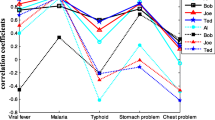Abstract
Correlation coefficients characterize relationships of various fuzzy sets and thus facilitate relevant applications. Regarding correlation coefficients of hesitant fuzzy sets (HFSs), a modified strategy of adjustment factor from hesitation degree is recently proposed, and the corresponding information enrichment can be probabilistically promoted to pursue correlation coefficients of probabilistic hesitant fuzzy sets (PHFSs). In this paper embracing PHFSs, a probabilistic adjustment factor is similarly constructed to modify an existing correlation coefficient, so an improved correlation coefficient is established; this new measure induces practical applications, mainly the decision making, medical diagnosis, and cluster analysis. According to PHFSs, the hesitation degree and adjustment factor are defined to achieve theoretical extensions, and the latter information factor is utilized to modify the existing correlation coefficient; thus, the new correlation coefficient emerges to offer improvements, and it acquires measure properties and example illustrations. Furthermore, the new and old correlation coefficients on PHFSs are comprehensively compared on the basis of a representative correlation coefficient on HFSs; accordingly, related correlation coefficients are applied in decision making, medical diagnosis, and cluster analysis, and our new correlation coefficient is verified to have the effectiveness and applicability.
Article highlights
-
A modified correlation coefficient in PHFSs is proposed by fusing an adjustment factor based on hesitation degrees.
-
The new correlation coefficient (CC) both extends an existing CC in HFSs and improves a current CC in PHFSs.
-
The new CC is applied to decision making, medical diagnosis, cluster analysis to gain effective contrastive performance.



Similar content being viewed by others
References
Torra, V.: Hesitant fuzzy sets. Int. J. Intell. Syst. 25(6), 529–539 (2010)
Xu, Z.S., Zhou, W.: Consensus building with a group of decision makers under the hesitant probabilistic fuzzy environment. Fuzzy Optim. Decis. Making 16(4), 481–503 (2017)
Zhu, B., Xu, Z.S.: Probability-hesitant fuzzy sets and the representation of preference relations. Technol. Econ. Dev. Econ. 24(3), 1029–1040 (2018)
Huang, J., Li, G., Wang, S.: Multi-label classification by exploiting local positive and negative pairwise label correlation. Neurocomputing 257, 164–174 (2017)
Zhou, H., Wang, X., Zhu, R.: Feature selection based on mutual information with correlation coefficient. Appl. Intell. 52(5), 5457–5474 (2022)
Ejegwa, P.A., Feng, Y., Zhang, W.: Pattern recognition based on an improved Szmidt and Kacprzyk’s correlation coefficient in Pythagorean fuzzy environment. In: International Symposium on Neural Networks, pp. 190–206. Springer, Cham (2020)
Zhao, J.P., Cao, Y., Wang, X.: The physical significance of the synthetic running correlation coefficient and its applications in oceanic and atmospheric studies. J. Ocean Univ. China 17, 451–460 (2018)
Lin, M., Huang, C., Chen, R.: Directional correlation coefficient measures for Pythagorean fuzzy sets: their applications to medical diagnosis and cluster analysis. Complex Intell. Syst. 7(2), 1025–1043 (2021)
Garg, H., Kumar, K.: A novel correlation coefficient of intuitionistic fuzzysets based on the connection number of set pair analysis and its application. Sci. Iran. 25(4), 2373–2388 (2018)
Zulqarnain, R.M., Xin, X.L., Saqlain, M.: TOPSIS method based on the correlation coefficient of interval-valued intuitionistic fuzzy soft sets and aggregation operators with their application in decision-making. J. Math. 2021, 1–16 (2021)
Xu, Z.S., Xia, M.: On distance and correlation measures of hesitant fuzzy information. Int. J. Intell. Syst. 26(5), 410–425 (2011)
Chen, N., Xu, Z.S., Xia, M.: Correlation coefficients of hesitant fuzzy sets and their applications to clustering analysis. Appl. Math. Model. 37(4), 2197–2211 (2013)
Liao, H., Xu, Z.S., Zeng, X.J.: Novel correlation coefficients between hesitant fuzzy sets and their application in decision making. Knowl.-Based Syst. 82, 115–127 (2015)
Guan, X., Sun, G., Yi, X.: Synthetic correlation coefficient between hesitant fuzzy sets with applications. Int. J. Fuzzy Syst. 20(6), 1968–1985 (2018)
Farhadinia, B., Liao, H., Herrera-Viedma, E.: A modified class of correlation coefficients of hesitant fuzzy information. Soft. Comput. 25(10), 7009–7028 (2021)
Wang, Z., Li, J.: Correlation coefficients of probabilistic hesitant fuzzy elements and their applications to evaluation of the alternatives. Symmetry 9(11), 259 (2017)
Song, C., Xu, Z.S., Zhao, H.: New correlation coefficients between probabilistic hesitant fuzzy sets and their applications in cluster analysis. Int. J. Fuzzy Syst. 21(2), 355–368 (2019)
Liu, X.D., Wang, Z., Zhang, S.: Novel correlation coefficient between hesitant fuzzy sets with application to medical diagnosis. Expert Syst. Appl. 183, 115393 (2021)
Li, H., Yang, Y., Yin, S.: Two \(\lambda\)-correlation coefficients of q-rung orthopair fuzzy sets and their application to clustering analysis. J. Intell. Fuzzy Syst. 39(1), 581–591 (2020)
Peng, Y., Liu, X.H., Sun, J.B.: A multi-attribute group decision making method considering both the correlation coefficient and hesitancy degrees under interval-valued intuitionistic fuzzy environment. Appl. Soft Comput. 104, 107187 (2021)
Singh, S., Sharma, S., Lalotra, S.: Generalized correlation coefficients of intuitionistic fuzzy sets with application to MAGDM and clustering analysis. Int. J. Fuzzy Syst. 22(5), 1582–1595 (2020)
Ullah, K., Garg, H., Mahmood, T.: Correlation coefficients for T-spherical fuzzy sets and their applications in clustering and multi-attribute decision making. Soft. Comput. 24(3), 1647–1659 (2020)
Ding, J., Xu, Z.S., Zhao, N.: An interactive approach to probabilistic hesitant fuzzy multi-attribute group decision making with incomplete weight information. J. Intell. Fuzzy Syst. 32(3), 2523–2536 (2017)
Krishankumar, R., Ravichandran, K.S., Liu, P.: A decision framework under probabilistic hesitant fuzzy environment with probability estimation for multi-criteria decision making. Neural Comput. Appl. 33(14), 8417–8433 (2021)
Lim, J., Wang, Z.: Multi-attribute decision making based on prioritized operators under probabilistic hesitant fuzzy environments. Soft. Comput. 23(11), 3853–3868 (2019)
Guo, J., Yin, J., Zhang, L.: Extended TODIM method for CCUS storage site selection under probabilistic hesitant fuzzy environment. Appl. Soft Comput. 93, 106381 (2020)
Krishankumar, R., Garg, H., Arun, K.: An integrated decision-making COPRAS approach to probabilistic hesitant fuzzy set information. Complex Intell. Syst. 7(5), 2281–2298 (2021)
Ren, L., Zhang, Y., Wang, Y.: Comparative analysis of a novel M-TOPSIS method and TOPSIS. Appl. Math. Res. Express 2007, abm005 (2007)
Acknowledgements
The authors thank the reviewers and editors for their valuable suggestions, which substantially improve this paper.
The work was supported by National Natural Science Foundation of China (61673285), Natural Science Foundation of Sichuan Province of China (2022NSFSC0929), Sichuan Science and Technology Program of China (2022ZYD0001, 2021YJ0085), and Joint Research Project of Laurent Mathematics Center of Sichuan Normal University and National-Local Joint Engineering Laboratory of System Credibility Automatic Verification (ZD20220101).
Author information
Authors and Affiliations
Corresponding author
Ethics declarations
Competing Interests
The authors declare that they have no conflict of interest.
Appendices
Appendix 1: Calculation Details of Example 1
Herein, we complement calculation details of Example 1. By Definition 3, we have
By Definition 4, we have
Similarly, we can get the surplus cases:
Appendix 2: A Special Case with Single-Element Universe Related to Example 1
Example 1 demonstrates a current correlation coefficient in HFSs [15] by virtue of a two-element universe. For further illustration, we supplement a special case of single-element universe. Let \(X=\{x_{1}\}\), and its three HFSs are
By Definition 3, we have
By Definition 4, we have
Similarly, we can get two surplus cases:
\(\square\)
Rights and permissions
Springer Nature or its licensor (e.g. a society or other partner) holds exclusive rights to this article under a publishing agreement with the author(s) or other rightsholder(s); author self-archiving of the accepted manuscript version of this article is solely governed by the terms of such publishing agreement and applicable law.
About this article
Cite this article
Liu, M., Zhang, X. & Mo, Z. A Modified Correlation Coefficient of Probabilistic Hesitant Fuzzy Sets and Its Applications of Decision Making, Medical Diagnosis, Cluster Analysis. Int. J. Fuzzy Syst. 25, 2609–2627 (2023). https://doi.org/10.1007/s40815-023-01509-x
Received:
Revised:
Accepted:
Published:
Issue Date:
DOI: https://doi.org/10.1007/s40815-023-01509-x




